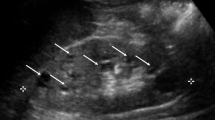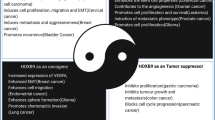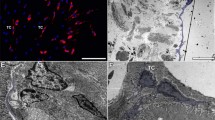Abstract
Mice lacking the imprinted Cdk inhibitor p57KIP2 have altered cell proliferation and differentiation, leading to abdominal muscle defects; cleft palate; endochondral bone ossification defects with incomplete differentiation of hypertrophic chondrocytes; renal medullary dysplasia; adrenal cortical hyperplasia and cytomegaly; and lens cell hyperproliferation and apoptosis. Many of these phenotypes are also seen in patients with Beckwith–Wiedemann syndrome, a pleiotropic hereditary disorder characterized by overgrowth and predisposition to cancer, suggesting that loss of p57KIP2 expression may play a role in the condition.
Similar content being viewed by others
References
1. Harper, J. W. & Elledge, S. J. Cdk inhibitors in development and cancer. Curr. Opin. Genet. Dev. 6,56-64 (1996). 2. Sherr, C. J. Cancer cell cycles. Science 274, 1672-1677 (1996). 3. Weinberg, R. A. The retinoblastoma protein and cell cycle control. Cell 81, 323-330 (1995). 4. Serrano, M. et al. Role of the INK4a locus in tumor suppression and cell mortality. Cell 85, 27-37 (1996). 5. Parker, S. B. et al. p53-Independent expression of p21Clpl in muscle and other terminally differentiating cells. Science 267, 1024-1027 (1995). 6. Deng, C. et al. Mice lacking p2iapl/WAF1 undergo normal development, but are defective in Gl checkpoint control. Cell 82, 675-684 (1995). 7. Nakayama, K. et al. Mice lacking p27KIP1 display increased body size, multiple organ hyperplasia, retinal displasia, and pituitary tumors. Cell 85, 707-720 (1996). 8. Kiyokawa, H. et al. Enhanced growth of mice lacking the cyclin-dependent kinase inhibitor function of p27KIP1. Cell 85, 721-732 (1996). 9. Fero, M. L. et al. A syndrome of multiorgan hyperplasia with features of gigantism, tumorigenesis, and female sterility in p27Kipl-deficient mice. Cell 85, 733-744 (1996). 10. Matsuoka, S. et al. p57KIP2, a structurally distinct member of the p21CIP1 Cdk-inhibitor family, is a candidate tumor suppressor gene. Genes Dev. 9, 650-662 (1995). 11. Lee, M. L. etal. Cloning of p57KIP2, a cyclin-dependent kinase inhibitor with unique domain structure and tissue distribution. Genes Dev. 9, 639-649 (1995). 12. Hastie, N. D. The genetics of Wilms' tumor-a case of disrupted development. Annu. Rev. Genet. 28, 523-558 (1994). 13. Wiedemann, H. R. Tumours and hemihypertrophy associated with Wiedemann-Beckwith syndrome. Eur. J. Pediatr. 141, 129-134 (1983). 14. Junien, C. Beckwith-Wiedemann syndrome, tumourigenesis and imprinting. Curr. Opin. Biol. 2, 431-438 (1992). 15. Matsuoka, S. et al. Imprinting of the gene encoding a human cyclin-dependent kinase inhibitor p57rap2, on chromosome llplS. Proc. Natl Acad. Sci. USA 93, 3026-3030 (1996). 16. Hatada, I. & Mukai, T. Genomic imprinting of p57KIP2, a cyclin-dependent kinase inhibitor, in mouse. Nature Genet. 11, 204-206 (1995). 17. Hoovers, J. et al Multiple genetic loci within Ilpl5.5 denned by Beckwith-Wiedemann Syndrome rearrangement breakpoints and subchromosomal transferable fragments. Proc. Natl Acad. Sci. USA 92, 12456-12460 (1995). 18. Hatada, I. et al An imprinted gene p57KIP2 is mutated in Beckwith-Wiedemann syndrome. Nature Genet. 14, 171-173 (1996). 19. Kaufman, M. H. The Atlas of Mouse Development (Academic, London, 1992). 20. Ferguson, M. J. W. Palate development. Development (suppl.) 103, 41-60 (1988). 21. Beckwith, B. Macroglossia, omphalocele, adrenal cytomegaly, gigantism, and hyperplastic visceromegaly. Birth Defects: Original Article Series 2 Vol. V No. 2 (ed. Bergsma, D.) 188-196 (The National Foundation, 1969). 22. Hepinstall, R. H. in Pathology of the Kidney Vol. 1, 114-155 (Little, Brown, Boston, MA, 1992). 23. Jacenko, O. et al. Spondylometaphyseal dysplasia in mice carrying a dominant negative mutation in a matrix protein specific for cartilage-to-bone transition. Nature 365, 56-61 (1993). 24. McAvoy, J. W. Induction of the eye lens. Differentiation 17, 137-149 (1996). 25. Morgenbesser, S. D. et al. p53-dependent apoptosis produced by Rb deficiency in the developing mouse lens. Nature 371, 72-74 (1994). 26. Cobrink, D. et al. Shared role of the Rb-related p!30 and p!07 proteins in limb development. Genes Dev. 10, 1633-1644 (1996). 27. Elliott, M. et al. Clinical features and natural history of Beckwith-Wiedemann syndrome: presentation of 74 new cases. Clin. Genet. 46, 168-174 (1994). 28. Takato, T., Kamei, M., Kato, K. & Kitano, I. Cleft palate in the Beckwith-Wiedemann syndrome. Ann. Plastic Surg. 22, 347-349 (1989). 29. Sotelo-Avila, C., Gonzalez-Crussi, F. & Fowler, J. W. Complete and incomplete forms of Beckwith-Wiedemann syndrome: their oncogenic potential/. Pediatr. 96, 47-50 (1980). 30. Leighton, P. A. et al Disruption of imprinting caused by deletion of the H19 gene region in mice. Nature 375, 34-39 (1995). 31. Weksberg, R., Shem, D. R., Song, Q. L. & Squire, J, Disruption of IGF2 imprinting in Beckwith-Wiedemann Syndrome. Nature Genet. 5, 143-149 (1993). 32. Ramirez-Solis, R. et al. Hoxb-4 (Hox-2.6) mutant mice show homeotic transformation of a cervical vertebra and defects in the closure of the sternal rudiments. Cell 73, 279-294 (1993). 33. Dynlacht, B. D. et al. Purification and analysis of CIP/KIP proteins. Methods Enzymol. (in the press).
Author information
Authors and Affiliations
Rights and permissions
About this article
Cite this article
Zhang, P., Liégeois, N., Wong, C. et al. Altered cell differentiation and proliferation in mice lacking p57KIP2 indicates a role in Beckwith–Wiedemann syndrome. Nature 387, 151–158 (1997). https://doi.org/10.1038/387151a0
Received:
Accepted:
Issue Date:
DOI: https://doi.org/10.1038/387151a0
- Springer Nature Limited
This article is cited by
-
Imprinted genes and the manipulation of parenting in mammals
Nature Reviews Genetics (2023)
-
5-methylcytosine RNA methyltransferases and their potential roles in cancer
Journal of Translational Medicine (2022)
-
DNA Methylation Analysis of Imprinted Genes in the Cortex and Hippocampus of Cross-Fostered Mice Selectively Bred for Increased Voluntary Wheel-Running
Behavior Genetics (2022)
-
Comparison of Gene Expression Patterns in Articular Cartilage and Xiphoid Cartilage
Biochemical Genetics (2022)
-
The CDK inhibitor p57Kip2 enhances the activity of the transcriptional coactivator FHL2
Scientific Reports (2020)





